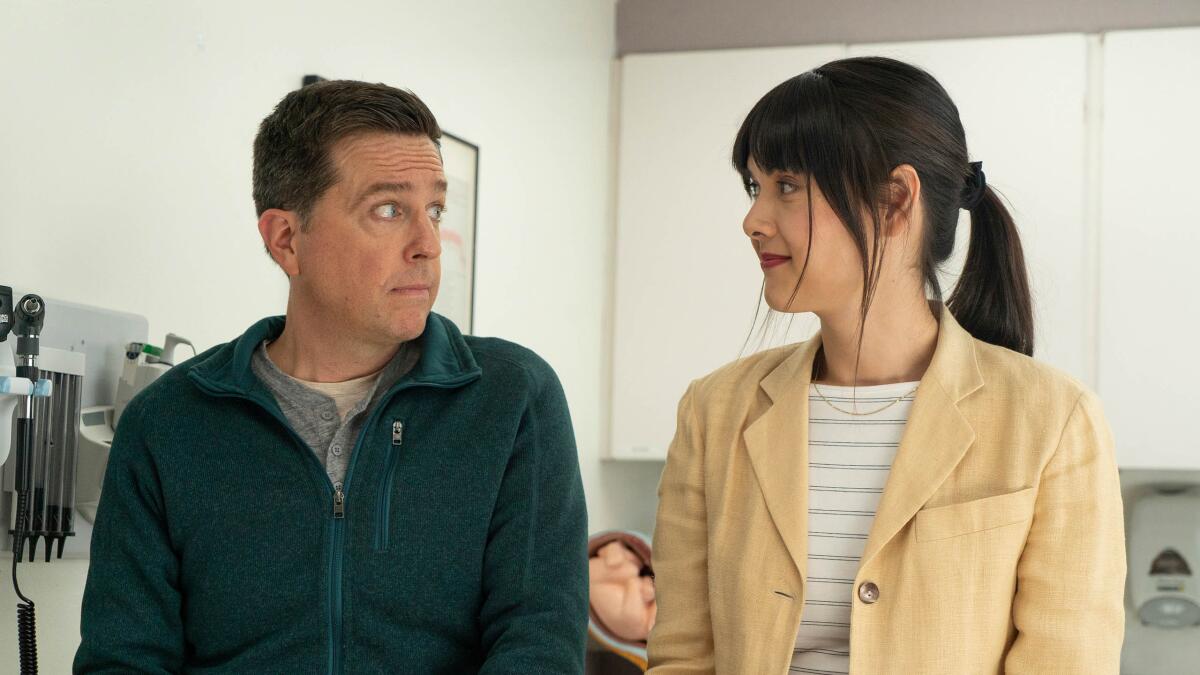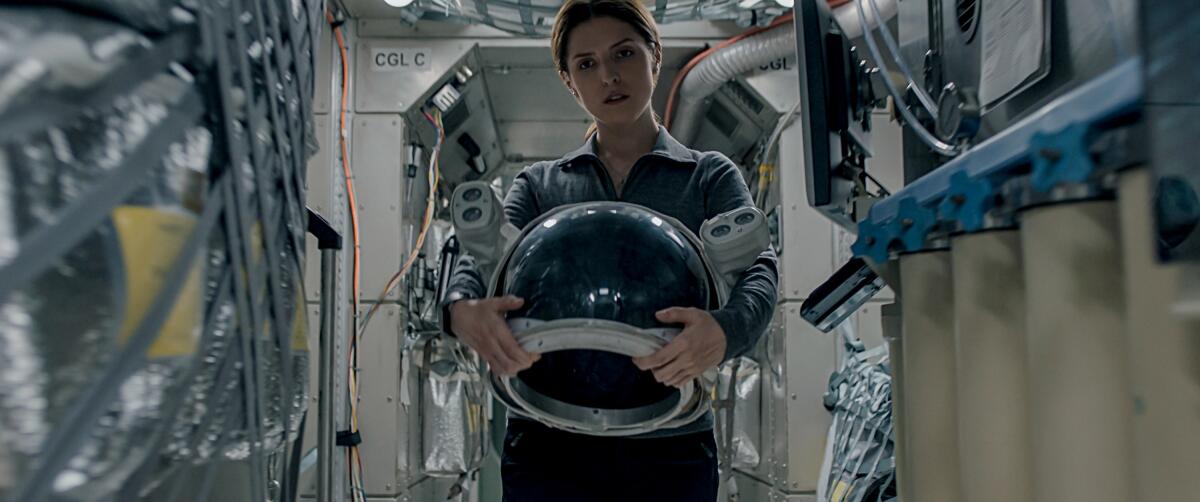Indie Focus: Loneliness and friendship in ‘Together Together’
Hello! I’m Mark Olsen. Welcome to another edition of your regular field guide to a world of Only Good Movies.
Only good movies
Get the Indie Focus newsletter, Mark Olsen's weekly guide to the world of cinema.
You may occasionally receive promotional content from the Los Angeles Times.
The Oscars are this Sunday, bringing an end to an extended awards season like no other.
Besides his predictions in all 23 categories, awards columnist Glenn Whipp wrote a piece about what to look for during the ceremony, such as just how much history will be made among the winners, the extremely competitive lead actress race and whether there will be joy in Husavik, Iceland.
The Spirit Awards were on Thursday, with “Nomadland” taking four prizes, “Sound of Metal” winning three and “Promising Young Woman” two.
For “The Envelope” podcast this week, I spoke to the writer-director of “Promising Young Woman,” Emerald Fennell, who is nominated for three Oscars for her debut feature.
Carolina A. Miranda wrote about the use of architecture among this year’s best picture nominees, noting, “In a movie season turned upside down by COVID-19, it seems right on brand that the eight best picture nominees for this year’s Academy Awards all channel a feeling of the unsettled — in their narratives, but also in the architecture that they depict. In these films, the aspirational, single family dwelling of the mid-20th century seems but a hazy dream. Instead, characters carve out their existence in the in-between spaces: vans, trailers, guest rooms and the ramshackle houses shared by activists fighting for a common cause.”
And a special mention should go to filmmaker Monte Hellman, who died this week at age 91. Best known for his 1971 film “Two-Lane Blacktop,” Hellman is the kind of filmmaker one would never really expect to see recognized by the Oscars, but who nevertheless deserves acclaim, recognition and respect as a singular artist. The Times once declared him “just about the best-kept secret in Hollywood.”
Enjoying this newsletter? Consider subscribing to the Los Angeles Times
Your support helps us deliver the news that matters most. Become a subscriber.
‘Together Together’
Written and directed by Nikole Beckwith, “Together Together” is about 40-something Matt (Ed Helms), who hires a 20-something woman named Anna (Patti Harrison) as a surrogate so he can be a single father. The two learn to navigate their relationship — are they colleagues, co-workers, friends or something more? The movie is in theaters now and will be on digital May 11.
When the film premiered at Sundance earlier this year, I moderated a panel with Beckwith, Harrison and Helms, and also had a separate conversation with Harrison, who was one of the breakout stars of this year’s festival.
For The Times, Robert Daniels wrote that the film “allows for fascinating subversions of the rom-com frame while remaining familiar at its core. Seeing disparate individuals brought together by chance, empathizing despite their differing backgrounds, is one of the things that draws us to films. … By the grace of a talented cast, especially the reliable Helms and the revelatory Harrison, ‘Together Together’ is a sweet, albeit incomplete search for companionship in the unlikeliest of places.”
For the New York Times, Jeannette Catsoulis wrote, “Remarkably, none of this comes across as creepy or offensive, simply as Matt’s bumbling attempts to be a caring expectant father. He may have the financial power, but she’s in charge, and he’s trying to temper his anxieties and respect her boundaries. … Refusing to turn cartwheels to make us laugh, Beckwith’s script can be at times a little bland. Yet its key conversations feel authentic in a way that’s rare in movies of this type, its restraint ceding ground to the movie’s soothing platonic rhythms as Matt and Anna figure out how to grow a life and a friendship at one and the same time.”
For rogerebert.com, Matt Zoller Seitz wrote, “‘Together Together’ is not just smart, it’s sneaky-smart. You go into it thinking you know what you’re getting yourself into, and feeling impatient or dismissive as a result, because the movie conspicuously makes choices that seem designed to announce which boxes it’s going to check off. Then it keeps confounding you — in a way that’s understated rather than show-offy — until you have to accept it on its own terms. It’s the perfect storytelling tactic for a movie about a surrogate mother and her patron, a divorced man 20 years her senior. The main characters don’t fully appreciate each other until they quit trying to categorize their relationship and let it be whatever it’s going to be, while trying not obsess over what’ll happen once the baby is born.”
For the Tribune News Service, Katie Walsh wrote, “This question of being alone in a world of togetherness, and what that looks like, and what it means, is the poignant underpinning of ‘Together Together,’ which imagines the nontraditional ways that the loners of this world can be alone, together. … As they navigate this series of choices together, Matt and Anna unexpectedly become friends, which adds an additional layer of complication to an already complex relationship. For two seemingly friendless people in what is an essentially transactional relationship, could they be friends, and furthermore, should they be?”

‘Stowaway’
Directed by Joe Penna, who co-wrote the screenplay with Ryan Morrison, “Stowaway” is the story of a space mission whose crew discovers there is an extra passenger aboard their ship. Anna Kendrick, Daniel Dae Kim, Shamier Anderson and Toni Collette make up the main cast in the movie, which is streaming now on Netflix.
For The Times, Jessica Kiang wrote, “Paradoxically, as ‘Stowaway’ becomes more overtly thrilling, it becomes less interesting, certainly to those of us nerds who are in it for the moral relativism arguments and the cool science. … And for the most part, aside from a slightly slack start, and its stirring but simplistic ending, that kind of well-researched procedural detail is what makes Penna’s film such an engrossing and surprisingly touching addition to a genre already bursting with splashier, more extravagant and more overtly sentimental titles.”
For Time, Stephanie Zacharek wrote, “Personally, I’m not sure I’d want to travel to Mars with Anna Kendrick. Doesn’t she seem a little high-strung for space? But her performance here has a quiet, simmering thoughtfulness, as if Zoe were a person who has always felt just a little out of step on Earth, able to find space scarily freeing. Collette has little to do beyond look at first annoyed, and then resigned, and then anguished by her responsibilities — but Collette, who can do anything, ultimately makes us feel the weight of the latter. … The infinity of space is terrifying, but also strangely cozy — as if, without borders, we’re at last free to be our truest selves.”

‘Sisters With Transistors’
Directed by Lisa Rovner and narrated by Laurie Anderson, the documentary “Sisters With Transistors” showcases women’s role in the development of electronic music, including such pioneers as Clara Rockmore, Delia Derbyshire, Daphne Oram and Wendy Carlos.
For The Times, Katie Walsh called the film “a vital historical corrective,” adding: “While ‘Sisters With Transistors’ is an important tribute to these women and their influence, it’s also a cinematic experience that melds the visuals to the abstract, hallucinatory sounds of their compositions. … Rovner’s film is about the music these women made as a reflection of the time and space they inhabited, but it’s also about the way they forged ahead without role models or representations of female composers of any kind. Hopefully, ‘Sisters With Transistors’ can fill that gap for a new generation.”
For the New York Times, Glenn Kenny said the film was “informative and often fascinating,” also saying that it, “is hardly as goofy as its title makes it sound. Many of the innovating individuals profiled here contend that women have an affinity for digital technology. And that technology had, and still has, the potential to ‘blow up the power structure.’”
For the Guardian, Leslie Felperin wrote, “The film touches on so many characters and ideas it could have been sliced up and rearranged in any number of ways without making gender the connective thematic thread. … Not that there’s anything to complain about regarding the woman-artist angle. In fact, a stray remark by contemporary composer Holly Herndon beautifully sums up the feedback loop of visible diversity and why it matters that female pioneers are honoured: ‘There is something psychological that happens when you can see yourself in the people who are being celebrated.’”

Only good movies
Get the Indie Focus newsletter, Mark Olsen's weekly guide to the world of cinema.
You may occasionally receive promotional content from the Los Angeles Times.




